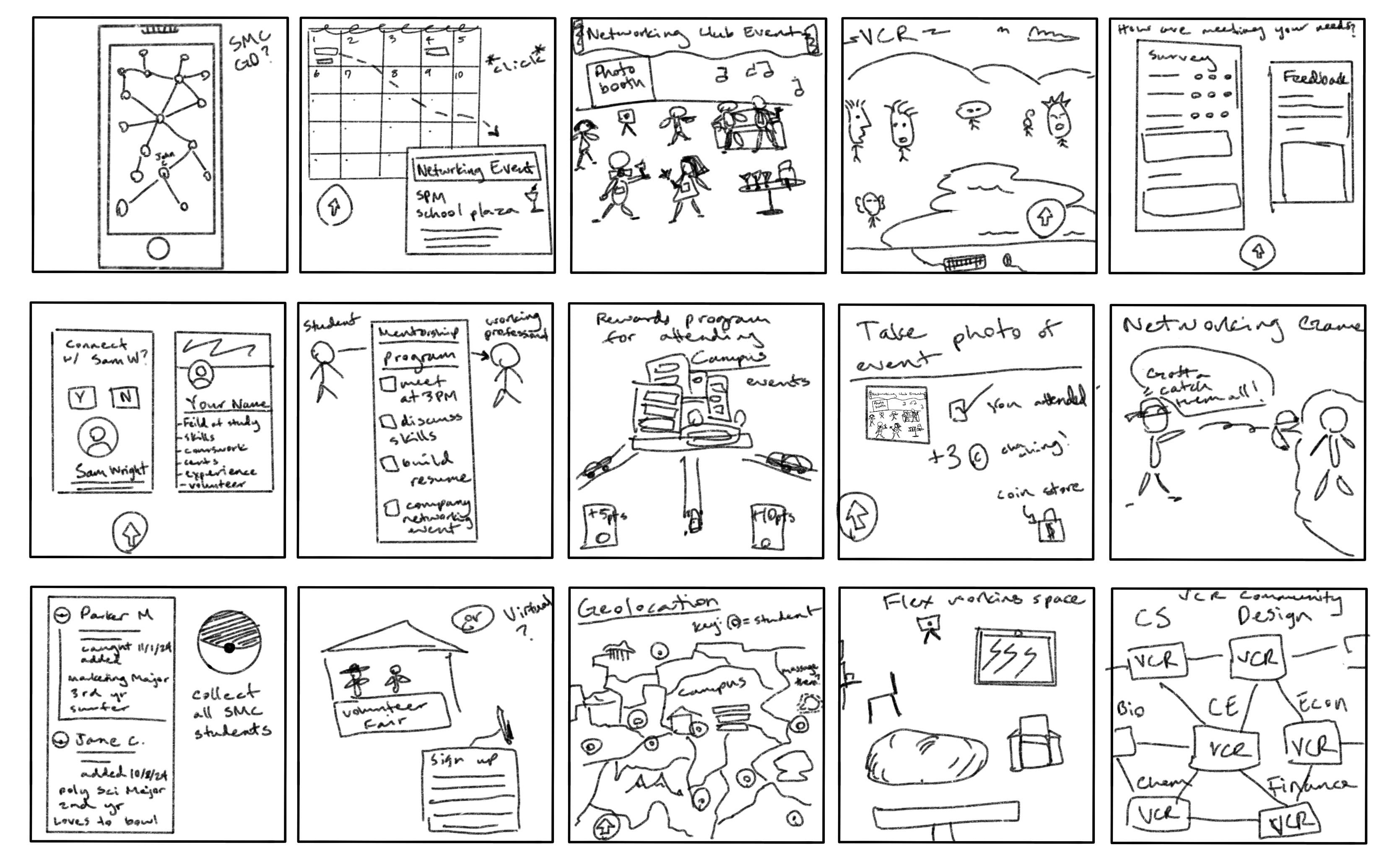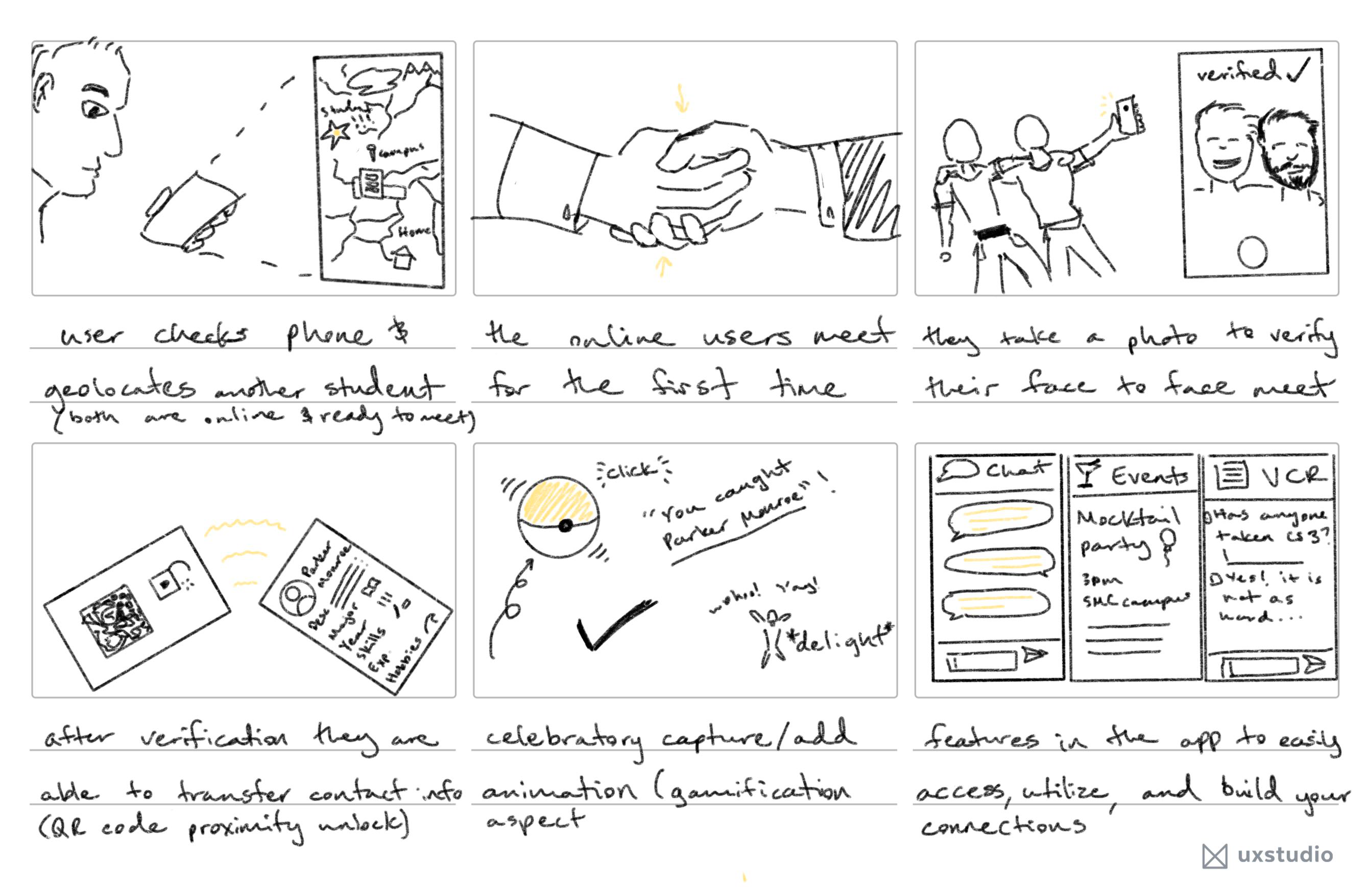
Brief: Identify an issue and offer a solution for creating community at Santa Monica College.
EduNet is a student networking app I designed to help commuter students build real, lasting connections on campus. It strengthens community by encouraging in-person meetups before adding digital connections, creating a more authentic and intentional way to grow one’s academic and professional network. By blending light gamification with practical tools, EduNet empowers students to form relationships that traditional college infrastructures often fail to support.
Product Designer
1.5 months
Figma
Procreate
Santa Monica College Project
Unlike students at traditional four-year universities, who often live on campus and naturally build relationships through clubs, events, and shared spaces, SMC students are largely commuters. This creates fewer opportunities to form the kinds of connections that enrich college life and extend into professional networks.
The challenge was clear: how could I, as a product designer, address the networking needs of SMC students and help them build meaningful relationships in a commuter school environment?


Through research, I discovered that students were already creating community outside of institutional resources—through Discord groups, social media, and informal meetups. Rather than replacing this initiative, I wanted to design a tool that empowered it.
That idea became EduNet, a gamified networking application built for commuter students. EduNet encourages users to meet in person before adding connections, creating a balance between real-world relationships and a digital rolodex that supports their academic and professional growth. By putting the power of action in students’ hands, the platform fosters authentic, lasting connections that SMC’s commuter environment currently struggles to provide
I began with a netnography of online platforms where SMC students were active, including Facebook, Reddit, Instagram, and Discord. From these spaces, I identified five examples of students expressing unmet needs—ranging from technical support to finding peer connections.
This research revealed early opportunity areas, such as student tutoring and mentorship, the role of social media in publicizing club events, and the difficulties faced by out-of-state students seeking community. I also noticed recurring issues with Canvas and e-services, particularly when technical problems disrupted access.
These insights helped narrow the project scope and gave me a foundation for identifying where design could truly support students
To build on my primary research, I reviewed scholarly and professional articles that explored strategies for student engagement and community building. These resources provided context and helped validate the opportunity areas I had uncovered in my netnography.
Key findings included the value of a unified online calendar to reduce search fatigue, the effectiveness of virtual common rooms (VCRs) in connecting students across disciplines, and the role of interactive maps in improving accessibility and campus engagement. Research also emphasized that students must be treated as key stakeholders in shaping and assessing their own academic environment.
These insights grounded my project in established knowledge while pointing me toward a clearer design direction for EduNet.
While conducting research interviews, one theme kept surfacing: networking.
Students consistently emphasized that building personal and professional connections was not only important for job security but also an essential part of the college experience, one that was lacking at SMC.

“The way I have experienced community [at SMC] has been primarily student led.”

“I feel like [SMC] doesn’t take student networking really seriously.”

“Right now it feels like students are’t that interested in building their networks and SMC isn’t that interested in helping that happen.”
To better understand community in student life, I asked interviewees to create journey maps of their time at SMC. This revealed how major academic events connected to their emotions: Theresa’s struggles with ADHD, Ricardo’s gratitude for financial aid, and Oliver’s mix of stress and excitement applying to the IxD program and serving as a club officer.
These stories showed that moments of stress and transition are when students most need connection and support

During the research phase, several key insights surfaced that shaped the direction of my project:
These insights underscored that students are eager for connection, but existing systems aren’t designed to support it.
Building upon the insights gathered from the research and especially the student interviews. I drilled down on the HMW statement in order to properly define the problem space.
Establishing this statement was critical for moving into problem-solving exercises like the 5 Whys and 5 W’s, which helped identify root causes and clarify the audience most affected.
↓
How might we create professional networking in a school environment that is geographically disconnected?
↓
Using my HMW statement as a guide, I created 15 thumbnail sketches of potential solutions. Sketching allowed me to quickly ideate, explore variations, and visualize different ways to foster networking at SMC.
Through this process, one promising concept emerged: EduNet, a gamified networking app designed for commuter students. Drawing inspiration from research that showed the strongest connections are made in person, I designed EduNet so that students must meet face-to-face before exchanging contact information. This ensured the app would balance authentic in-person interactions with the convenience of a digital rolodex accessible anytime.

Through EduNet, a student can set a time and place to meet another verified student or alumni. Once they meet in person and verify, they can exchange digital contact cards in the app.
Drawing inspiration from Pokémon Go, I designed the experience to include animations and sound effects whenever a new contact is added—turning networking into a delightful, game-like interaction. This collection-oriented approach motivates students to grow their networks while still anchoring the experience in real-world meetings.
After adding a contact, students can communicate and engage digitally with their network through EduNet’s features, building relationships that support both community belonging and future job security.

After creating my storyboard, I developed a storycast—a narrated walkthrough where I verbally described each scene and how the interactions would play out. This exercise helped me clarify the flow of events, ensure the logic of each interaction, and communicate the scenario more effectively to others.
Storycasting not only gave me a new tool for testing and presenting ideas, but also helped me step into the user’s shoes, making the storyboard feel more tangible and immersive.
After presenting my final storyboard and storycast, I received detailed feedback from both my professor and fellow students. Their perspectives revealed new benefits and pitfalls of my community application that I hadn’t considered during the design process.
The feedback highlighted the strength of the app’s networking potential and how its gamification could motivate students to engage. At the same time, it surfaced important concerns, such as privacy, safety, and feasibility, that would need to be addressed in future iterations.
This step reminded me that design doesn’t end at ideation. It’s a process of continuous validation, critique, and iteration.
To bring EduNet to life for decision-makers, I created a pitch deck tailored for stakeholders at Santa Monica College. The deck outlined the problem, research insights, proposed solution, and potential impact of the app.
I then delivered a virtual pitch to a hypothetical SMC board in video format. This exercise gave me the chance to practice not only storytelling and persuasion but also framing design work in terms of institutional goals, student needs, and long-term value.
By simulating this presentation, I learned how to translate design into strategy, preparing me for future conversations with real stakeholders.
Designing networking as a gamified application for SMC students highlighted its potential to strengthen community and improve job security. Throughout this project, I gained new skills—like storycasting, presenting a pitch deck, more effective paper brainstorming, and applying the right types of research to inform a product. I also cemented the importance of interviewing for problems, not solutions, a shift that has improved my process as a designer.
Looking back, I would have liked to interview more students and further develop EduNet’s use cases and features. Moving forward, I see value in creating a low-fidelity Figma prototype to test the proposed features for usability.

What worked
Students were energized by the gamification concept and excited about meeting verified peers. One participant even compared the idea to MeetUp in its early stages.

What didn't work
Feedback surfaced valuable concerns around privacy and geolocation safety, which will need to be addressed in future iterations.